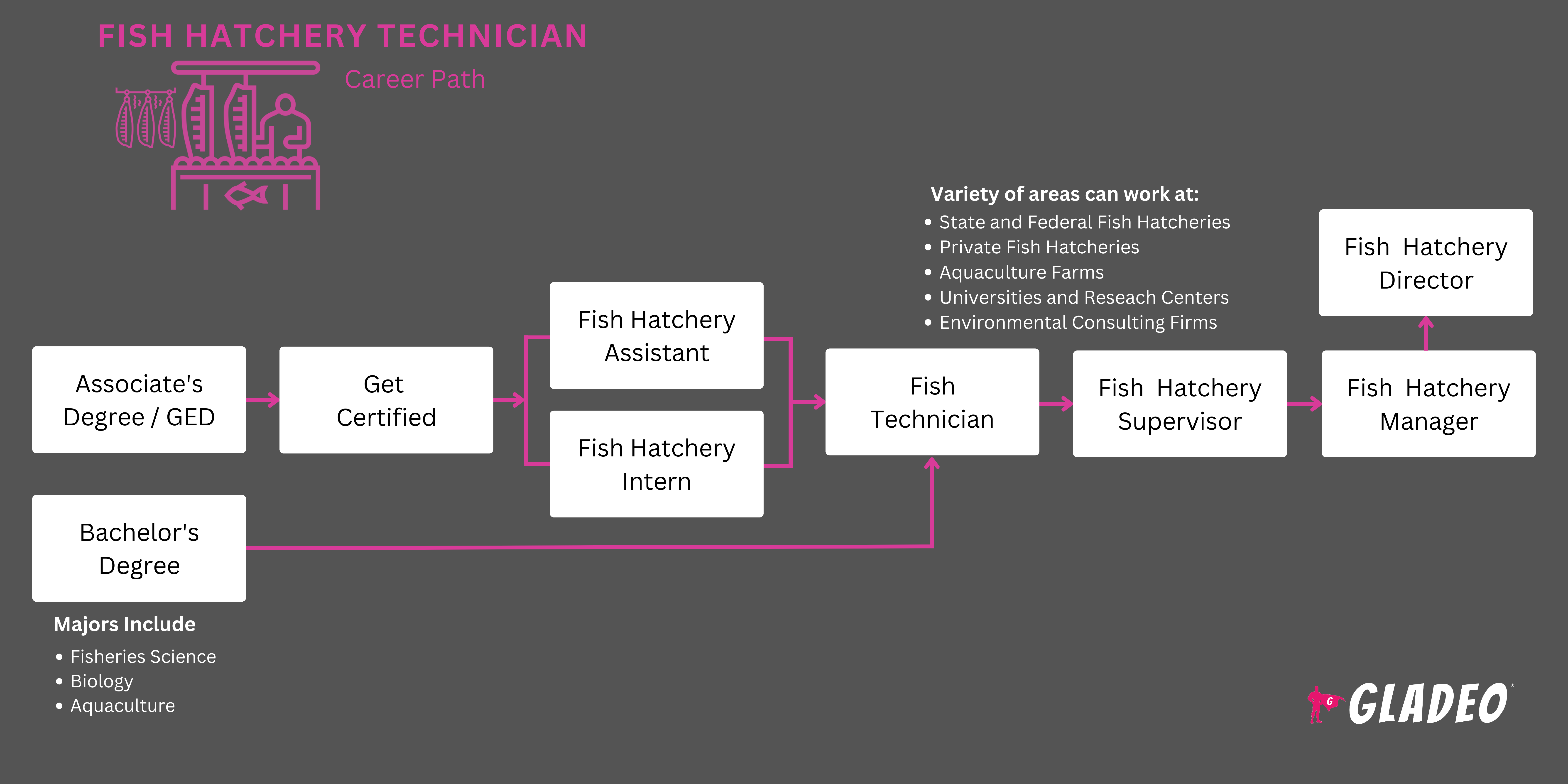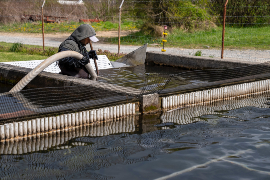Spotlights
Fish Culture Technician, Fish Farm Technician, Aquaculture Technician. Fish Rearing Specialist, Hatchery Assistant, Aquatic Biologist Technician, Fishery Technician, Fish Health Technician
Fish hatcheries are facilities where fish eggs are hatched and raised under controlled, optimal environmental conditions where they can thrive. They are later transferred or released into other bodies of water. As U.S. Fish & Wildlife Service notes, hatcheries also “recover endangered or threatened species, “improve recreational fishing,” and “stock 98 million fish every year into rivers and lakes.”
Fish Hatchery Technicians play an essential role in these operations. They do most of the manual tasks required to keep the hatcheries running smoothly. From taking care of the facilities and grounds to feeding the fish, keeping their water fresh and at an appropriate temperature, and even counting their eggs, Fish Hatchery Technicians are so important that some employers have them live on-site!
- Protecting fish and enabling conditions for them to propagate
- Helping to balance fragile ecosystems
- Ensuring sufficient fish populations for commercial use and fishing
Lịch làm việc
- Fish Hatchery Technicians work full-time, with overtime possible during busy periods. They work outdoors in various weather conditions and perform a good amount of physical labor throughout the day.
Nhiệm vụ tiêu biểu
- Feed fish populations in controlled, specialized ponds, tanks, or other artificial channels (aka raceways)
- Ensure the water quality and temperature are suitable for the type of fish being taken care of, to closely emulate their natural habitats
- Some hatcheries receive freshwater or saltwater from natural sources; others use groundwater, municipal water, recirculated water in a closed-loop system, or even rainwater)
- Maintain equipment such as pumps, fish feeders, screens, filters, etc.
- Trap and sample fish from hatchery populations; monitor eggs as they hatch into the “fry” stage and grow into “fingerlings”
- Keep track of fish population numbers; maintain records of numbers and weights of fish released or sold
- Monitor for signs of microorganisms or disease
- Treat or segregate diseased fish quickly, and remove dead fish
- Harvest, count, and weigh eggs, as needed
- Transport fish and fish eggs; release mature fish into natural bodies of water to restock them. Distribute some fish to customers
- Perform general groundskeeping, including cutting grass and maintaining roads and trails
- Maintain facilities and vehicles; keep track of mileage driven; help order supplies and accept deliveries
Trách nhiệm bổ sung
Limit or control access to certain off-limits facilities and production areas to reduce the risk of disease spread (note, some hatcheries are open to the public and even feature tours!)
Respond to questions from visitors or the general public
Create or follow emergency plans to address biosecurity incidents
Keep up-to-date on employer policies and rules, as well as state and federal guidelines and regulations
Assist with training new team members, volunteers, or community service workers
Kỹ năng mềm
- Trách nhiệm
- Định hướng chi tiết
- Suy luận suy diễn
- Sáng kiến
- Tinh ý
- Tổ chức
- Giải quyết vấn đề
- Stamina
- Kỹ năng giao tiếp mạnh mẽ
- Quản lý thời gian
Kỹ năng kỹ thuật
- Kỹ năng máy tính cơ bản
- Basic laboratory techniques
- Biology, wildlife, geography, and math
- Carry and load heavy objects
- Nhập dữ liệu, thu thập dữ liệu và lưu trữ hồ sơ
- Fish breeding (i.e., spawning, fertilization, egg collection, incubation, hatching)
- Fish health assessment, disease prevention, and treatment methods
- Hatchery policies, regulations, and laws
- Operate and maintain vehicles (i.e., small boats, ATVs, pickups, utility vehicles, snowmobiles, loaders, etc.)
- Operating/maintaining filtration systems and recirculation equipment, pumps, aerators, and feeding systems
- Small power tools (and firearms, for some jobs); calibration of specialized instruments
- Water quality management (i.e., temperature, pH, dissolved oxygen, and ammonia levels) and water dynamics (flows, flow patterns)
- Water safety, first aid, CPR
- Wear of personal protective equipment
- Commercial hatcheries
- Các cơ quan chính quyền liên bang, tiểu bang hoặc địa phương
Per Cal Poly Humboldt, the following are potential employers for fisheries biology majors:
Cơ quan liên bang
- Công binh Lục quân
- Cục Các vấn đề Ấn Độ
- Cục Quản lý đất đai
- Cục Khai hoang
- Cơ quan bảo vệ môi trường
- Federal Power Administration
- Fish & Wildlife Services
- Forest Services
- Marine Advisory Extension Services
- National Marine Fisheries Services
- National Oceanic & Atmospheric Administration (NOAA)
- National Park Services
- Natural Resources Conservation Services
- Quân đoàn Hòa bình
- Smithsonian Institute
- U.S. Customs Services
- Cục Khảo sát Địa chất Hoa Kỳ
State & County agencies
- Fish & Game Departments
- Parks & Recreation Departments
- Public Aquariums
- Water Resource Control Boards
- Water Resource Departments
Các tổ chức tư nhân
- Aquaculture & Mariculture Companies
- Aquarium & Pet Supply Companies
- Environmental Consultants
- Manufacturing Companies
Public utility companies
- Timber Product Companies
- Water Quality Monitoring Equipment
Fish Hatchery Technicians are responsible for monitoring fish and eggs, feeding fish, maintaining water quality in tanks and ponds, and cleaning equipment to ensure the fish and eggs under their care are healthy and able to thrive.
Fish Hatchery Technicians need to cultivate a good understanding of fish biology and behavior, so they can watch out for problems. They must follow strict protocols to prevent or control disease outbreaks that can endanger the hatchery’s entire fish population. Attention to detail, physical stamina, and the ability to work outdoors are all critical to do this job. Some technicians live at remote sites and may be required to carry a firearm.
In the field of fish hatcheries, there’s an increased focus on sustainable practices and conservation efforts. Many hatcheries are prioritizing the production of native and endangered fish species to restore and maintain natural ecosystems. This shift aligns with concerns about biodiversity loss and habitat degradation, driving hatcheries to play a more active role in preserving aquatic environments.
The integration of technology and data-driven approaches is another trend. Advanced monitoring systems, sensors, and automated feeding mechanisms are being adopted to optimize fish growth and health while allowing technicians to better track water quality parameters, feeding schedules, and fish behavior. Data analytics and modeling also help hatcheries adapt to changing environmental conditions and optimize resource allocation!
Fish Hatchery Technicians are typically physically active people who prefer working outdoors versus staying in an office all day. They may have always had a keen interest in fish, perhaps having aquariums—or just doing a lot of fishing in their younger days!
- Fish Hatchery Technicians need at least a high school diploma or GED. Entry-level positions at small facilities probably won’t require a college degree
- Workshops and standalone courses are a great way to learn hatchery techniques, equipment operation, and best practices
- On-the-Job training is provided but having hands-on experience in aquaculture or fisheries management (via volunteering or part-time jobs) may give you a boost
- Larger hatcheries might require an associate’s in aquaculture, fisheries and wildlife management, fisheries biology, or marine science
- Higher-level technician roles involving research, management, or complex operations require a bachelor’s or higher. Undergraduate class topics may include:
- Aquatic ecology
- Biometrics
- Dendrology
- Ecosystems
- Equipment usage
- Fish management
- Habitat maintenance
- Ichthyology
- Ornithology
- Sinh lý học
- Population dynamics
- Wildlife genetics
- Biosecurity training to manage disease prevention might be necessary. Topics include quarantine procedures, hygiene, sanitation, pathogen testing, control of invasive species, etc.
- A valid driver’s license, boater education card, ATV safety card, or forklift operator certification may be needed
- Workers who apply pesticides often need a license. Some positions require training in firearm use
- Workers may complete additional certifications such as Auburn’s Certification for Aquaculture Professionals or CWEA’s Laboratory Analyst Certification
- Not all Fish Hatchery Technicians need a college degree, but it can be helpful to complete classes in aquaculture, fisheries and wildlife management, biology, or marine science. Seek programs with internships or opportunities to get practical experience
- So sánh chi phí học phí và lệ phí, lưu ý chi phí trong tiểu bang so với ngoài tiểu bang
- Xem xét các lựa chọn học bổng và hỗ trợ tài chính
- Xem liệu chương trình có bất kỳ quan hệ đối tác nào với các công ty thuê sinh viên tốt nghiệp không!
- Lưu ý thống kê tốt nghiệp và giới thiệu việc làm cho cựu sinh viên
- Fish Hatchery Technicians perform lots of manual labor tasks, so engage in regular workouts to stay in shape
- In high school, study biology, environmental science, chemistry, math, agriculture or aquaculture, animal science, and physics
- Go camping, hiking, or fishing to get used to being outdoors a lot (if you aren’t already!)
- Get your driver’s license and consider applying for a CDL. You may also want to get a boater education card and/or ATV safety education card
- Learn about the different types of fish that are raised in hatcheries, such as trout, salmon, catfish, bass, walleye, and tilapia
- Read about the history of why they are raised and what happens to them when they mature (for example, are they released into ponds or rivers, or sold to businesses?)
- Watch videos such as Wyoming Game and Fish Department’s YouTube channel
- Check out the videos Trout Hatchery Tour - See How A Hatchery Works! and Fish Hatchery - Daniel, Wyoming!
- Talk to working Fish Hatchery Technicians. Ask about their jobs and what they recommend for education and training. See if it is possible to shadow them for a day or volunteer
- Because technicians have direct access to valuable fish populations which may be used as sources of food later, technicians must often undergo a criminal background check!

- Check out job portals like Indeed.com, LinkedIn, Glassdoor, Monster, CareerBuilder, SimplyHired, ZipRecruiter, USAJOBS, etc.
- Take note of keywords in job postings. Tailor your resume to include them, while highlighting your relevant education and experience
- If you don’t have the necessary experience for certain jobs, don’t give up. Keep looking for entry-level or associated positions until you find one that you qualify for. If that doesn’t work, take a few classes to beef up your application
- Attend recruitment events. Many governmental agencies go to job fairs ready to hire. Come dressed nicely and prepared to ask questions and give mature responses
- Nếu bạn tham gia các khóa học đại học, hãy hỏi người hướng dẫn hoặc bạn học về những cơ hội mà họ biết hoặc các kết nối mà họ có. Nhiều công việc được tìm thấy thông qua mạng!
- Ask working Fish Hatchery Technicians how they landed their jobs
- The U.S. Fish and Wildlife Service’s hatchery system features ~70 national hatcheries plus a handful of fish technology or health centers. Consider moving closer to one, if you want a job there. Otherwise, look for commercial hatchery locations!
- Lập danh sách các tài liệu tham khảo cá nhân tiềm năng. Nhận quyền chia sẻ thông tin liên hệ của họ trước thời hạn
- Brush up on hatchery practices and terminology. During interviews, demonstrate your knowledge of the fish hatchery business and highlight your commitment to safety—both for yourself and the fish!
- Review sample Fish Hatchery Technician resumes and interview questions
- Nhờ một người bạn (hoặc trung tâm hướng nghiệp của trường bạn) giúp bạn thực hiện một số cuộc phỏng vấn giả
- Trước khi đi phỏng vấn, hãy đảm bảo nghiên cứu trang web của nhà tuyển dụng để tìm hiểu thêm về hoạt động của họ
- Take excellent care of the fish and eggs you are responsible for
- Ask questions and learn all you can about every aspect of the hatchery operation
- Let your supervisor know that you want to master your job and are interested in advancement opportunities when the time is right. Ask for their advice about what you should do to make yourself a stronger asset to the organization
- If a degree is required to advance, consider taking classes and see if the organization offers tuition assistance. Some employers might send you to classes if you ask
- Actively seek opportunities to gain leadership and managerial experience
- Practice outstanding safety at all times to show you’re a responsible worker!
- Maintain good physical fitness so you’ll have the stamina to do your duties
- Show up for work on time and take good care of tools, equipment, and vehicles
- Work effectively as part of a team and try to offer solutions to problems that come up
- Participate in professional organizations (see our list of Recommended Tools/Resources)
- Offer to give tours or teach workshops so you can get practice engaging with the public
- Learn about the sales and marketing side of the hatchery business
- Đào tạo công nhân mới kỹ lưỡng. Đặt tiêu chuẩn cao để họ sẽ học cách thực hiện công việc một cách an toàn
- Stay up to date on trends and industry changes that improve performance and reduce health risks for fish and eggs
Promotions are typically based on a mix of your job performance, knowledge and skills, and alignment with the employer’s needs. By consistently excelling in your current role, displaying leadership qualities, and actively contributing to the hatchery’s success, you increase your chances of being considered for a promotion!
Các trang web
- AFS Fish Health Section
- American Association of Fish Veterinarians
- Hiệp hội Thủy sản Hoa Kỳ
- Nuôi trồng thủy sản
- Aquatic Animal Drug Approval Partnership Program
- Cục Quản lý đất đai
- Freshwater Fisheries Society of British Columbia
- Idaho AFS: History of Aquaculture in Idaho
- Journal of the World Aquaculture Society
- Long Live the Kings
- Maryland Shad Restoration
- National Aquaculture Association
- National Association of State Aquaculture Coordinators
- Hiệp hội Quốc gia của Bộ Nông nghiệp Nhà nước
- Hiệp hội Lâm nghiệp Nhà nước Quốc gia
- Dịch vụ Công viên Quốc gia
- North American Journal of Aquaculture
- Northwest Indian Fisheries Commission
- Pacific Northwest Hatchery Reform Project
- The Return of American Shad to the Potomac River: 20 Years of Restoration
- Hiệp hội động vật hoang dã
- U.S. Aquaculture Society
- Dịch vụ Cá và Động vật hoang dã Hoa Kỳ
- Cục Lâm nghiệp Hoa Kỳ
- USFWS Federal Hatchery Review
- Virginia American Shad Restoration
- World Aquaculture Society
Sách vở
- Fish Hatchery Management, by American Fisheries Society
- Lessons in Leadership: Integrating Courage, Vision, and Innovation for the Future of Sustainable Fisheries, edited by William Taylor, Andrew Carlson, Abigail Bennett, and C. Paola Ferreri
- Methods for Fish Biology, edited by Stephen Midway, Caleb Hasler, and Prosanta Chakrabarty
- Trout and Salmon of the Genus Salmo, by Johannes Schöffmann
Fish Hatchery Technician work can, at times, be fun, exciting, dull, or dangerous. Every day comes with its own unique set of challenges. While many people love this line of work, it is not for everyone! If you’re curious about related career fields, consider some of the below options:
- Người nuôi trồng thủy sản
- Aquatic Biologist
- Aquatic Ecologist
- Aquatic Pathologist
- Kỹ thuật viên sinh học
- Fish & Game Warden
- Fish & Wildlife Assistant
- Fish Behaviorist
- Fish Culturist
- Fisheries Biologist
- Fisheries Conservationist
- Fishery Scientist
- Fish Hatchery Manager
- Fish Health Inspector
- Habitat Restoration Specialist
- Nhà sinh học biển
- Research Biologist
- Reservoir Manager
Nguồn cấp tin tức

Công việc nổi bật

Các khóa học và công cụ trực tuyến







